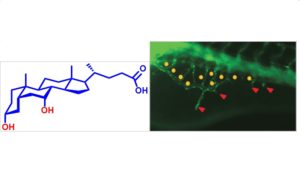
Dr. Avinash Bajaj’s lab is primarily focused in the development and finding of new drug delivery molecules and bio-inspired materials for the betterment of conventional chemotherapeutic strategies. Over the years his group exploited bile acids in developing cancer targeting cationic lipids, bile acid based drug conjugates, and further designed bile acid-phosphocholine- derived phospholipids for drug encapsulations and controlled release. Now his group simply explored categorically how the hydrophobic and hydrophilic bile acids modulate angiogenesis. Teaming with Dr. Chetana Sachidanandan and Dr. Rajender K. Motiani, from Institute of Genomics and Integrated Biology (IGIB) they screened the bile acids in transgenic zebrafish embryos and further validated the mechanism using Human Umbilical Vein Endothelial Cells (HUVECs) to find out the contribution of hydrophilic bile acids Cholic Acid (CA), and Chenodeoxycholic Acid (CDCA) and hydrophobic bile acids like Lithocholic Acid (LCA) and Deoxycholic Acid (DCA) in angiogenesis. The findings concluded as CDCA promotes angiogenesis by increasing the expression of vascular growth factor receptors (VEGFR1 and VEGFR2) and matrix degrading peptidases (MMP9); and; lowering the cell adhesion protein Vascular Endothelial Cadherin (VE-Cadherin). This work describes how a biological function like angiogenesis is dictated by nature of bile acids. It holds a promise for future exploration of bile acid conjugates and chemical modifications in therapeutic aspects of various angiogenesis related disease.
For More Details: Deciphering the Role of Hydrophobic and Hydrophilic Bile Acids in Angiogenesis using in vitro and in vivo Model Systems
Med. Chem. Commun., 2017, DOI: 10.1039/C7MD00475C.

